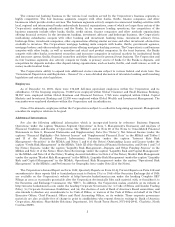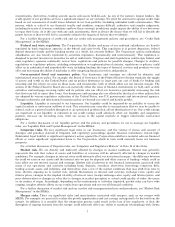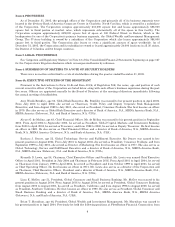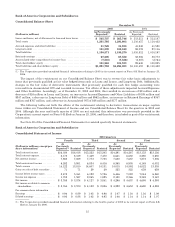Bank of America 2005 Annual Report Download - page 42
Download and view the complete annual report
Please find page 42 of the 2005 Bank of America annual report below. You can navigate through the pages in the report by either clicking on the pages listed below, or by using the keyword search tool below to find specific information within the annual report.The Corporation’s Annual Report on Form 10-K is being distributed to stockholders in lieu of a separate annual
report containing financial statements of the Corporation and its consolidated subsidiaries.
Item 1A. RISK FACTORS
This report contains certain statements that are forward-looking within the meaning of the Private Securities
Litigation Reform Act of 1995. These statements are not guarantees of future performance and involve certain risks,
uncertainties and assumptions that are difficult to predict. Actual outcomes and results may differ materially from those
expressed in, or implied by, our forward-looking statements. Words such as “expects,” “anticipates,” “believes,”
“estimates” and other similar expressions or future or conditional verbs such as “will,” “should,” “would” and “could” are
intended to identify such forward-looking statements. Readers of this annual report of the Corporation (also referred to
as we, us or our) should not rely solely on the forward-looking statements and should consider all uncertainties and risks
throughout this report. The statements are representative only as of the date they are made, and we undertake no
obligation to update any forward-looking statement.
All forward-looking statements, by their nature, are subject to risks and uncertainties. Our actual future results
may differ materially from those set forth in our forward-looking statements. As a large, international financial services
company, we face risks that are inherent in the businesses and the market places in which we operate. Factors that
might cause our future financial performance to vary from that described in our forward-looking statements include the
market, credit, operational, regulatory, strategic, liquidity, capital, economic and sovereign risks, among others, as
discussed in the MD&A and in other periodic reports filed with the SEC. In addition, the following discussion sets forth
certain risks and uncertainties that we believe could cause actual future results to differ materially from expected
results. However, other factors besides those listed below or discussed in our reports to the SEC also could adversely
affect our results, and the reader should not consider any such list of factors to be a complete set of all potential risks or
uncertainties.
General business, economic and political conditions. Our businesses and earnings are affected by general
business, economic and political conditions in the United States and abroad. Given the concentration of our business
activities in the United States, we are particularly exposed to downturns in the United States economy. For example, in
a poor economic environment there is a greater likelihood that more of our customers or counterparties could become
delinquent on their loans or other obligations to us, which, in turn, could result in a higher level of charge-offs and
provision for credit losses, all of which would adversely affect our earnings. General business and economic conditions
that could affect us include short-term and long-term interest rates, inflation, monetary supply, fluctuations in both debt
and equity capital markets, and the strength of the Unites States economy and the local economies in which we operate.
Geopolitical conditions can also affect our earnings. Acts or threats of terrorism, actions taken by the United States or
other governments in response to acts or threats of terrorism and/or military conflicts, could affect business and
economic conditions in the United States and abroad.
Access to funds from subsidiaries. The Corporation is a separate and distinct legal entity from our banking and
nonbanking subsidiaries. We therefore depend on dividends, distributions and other payments from our banking and
nonbanking subsidiaries to fund dividend payments on the common stock and to fund all payments on our other
obligations, including debt obligations. Many of our subsidiaries are subject to laws that authorize regulatory bodies to
block or reduce the flow of funds from those subsidiaries to the Corporation. Regulatory action of that kind could impede
access to funds we need to make payments on our obligations or dividend payments. In addition, the Corporation’s right
to participate in a distribution of assets upon a subsidiary’s liquidation or reorganization is subject to the prior claims of
the subsidiary’s creditors.
Changes in accounting standards. Our accounting policies and methods are fundamental to how we record and
report our financial condition and results of operations. From time to time the Financial Accounting Standards Board
(“FASB”) changes the financial accounting and reporting standards that govern the preparation of our financial
statements. These changes can be hard to predict and can materially impact how we record and report our financial
condition and results of operations. In some cases, we could be required to apply a new or revised standard retroactively,
resulting in our restating prior period financial statements.
Competition. We operate in a highly competitive environment that could experience intensified competition as
continued merger activity in the financial services industry produces larger, better-capitalized companies that are
capable of offering a wider array of financial products and services, and at more competitive prices. In addition,
technological advances and the growth of e-commerce have made it possible for non-depository institutions to offer
products and services that traditionally were banking products, and for financial institutions to compete with technology
companies in providing electronic and Internet-based financial solutions. Many of our competitors have fewer regulatory
constraints and some have lower cost structures.
Credit Risk. When we loan money, commit to loan money or enter into a contract with a counterparty, we incur
credit risk, or the risk of losses if our borrowers do not repay their loans or our counterparties fail to perform according
to the terms of their contract. A number of our products expose us to credit risk, including loans, leases and lending
6
























